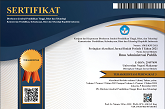Application of Organizational Culture at the Civil Service Police Unit
(1) Universitas Pohuwato
(2) Universitas Pohuwato
(*) Corresponding Author
DOI: https://doi.org/10.26858/jiap.v11i2.27578
Abstract
Keywords
Full Text:
PDFReferences
Davis, K. dan Newstrom, J. W. (1993). Organizational Behavior, 9th ed. McGraw-Hill Inc.
Deal, T. E. dan Kennedy, A. A. (2000). Corporate Cultures: The Rites and Rituals of Corporate Life. Perseus Books.
George, J. M. dan Jones, G. R. (2011). Understanding and Managing Organizational Behavior, 6th ed. Pearson Education.
Luthans, F. (2011). Organizational Behavior: An Evidence-Based Approach, 12th ed. McGraw-Hill.
Owens, R. G. (1998). Organizational Behavior in Education. Allyn and Bacon,
Robbins, S. P. (1996). Organizational Behavior: Concepts, Controversies, Applications. Prentice Hall.
Sathe, V. (1985). Culture and Related Corporate Realities: Text, Cases, & Readings on Organizational Entry, Establishment & Change. Richard d Irwin.
Schein, E. H. (2010). Organizational Culture and Leadership, 4th ed. Jossey-Bass.
Stoner, J. F. Freeman, R. E. dan Gilbert, D. R. (1994). Management, 6th ed. Pearson.
Tosi, H. L. Carroll, S. dan J. Rizzo. (1994). Managing Organizational Behavior. New Jersey.
Article Metrics
Abstract view : 218 times | PDF view : 39 timesRefbacks
- There are currently no refbacks.
Copyright (c) 2022 Rusni Djafar

This work is licensed under a Creative Commons Attribution 4.0 International License.
Diterbitkan oleh:
Program Studi Ilmu Administrasi Publik
Program Pascasarjana Universitas Negeri Makassar
JIAP Index By:

This work is licensed under a Creative Commons Attribution 4.0 International License.









